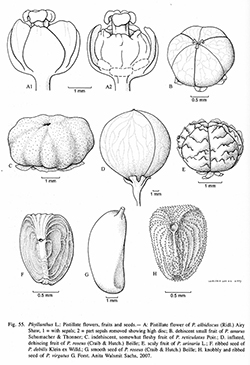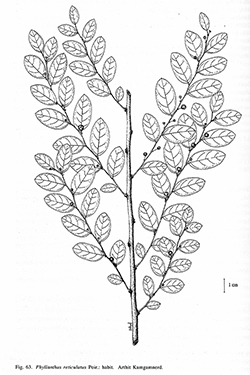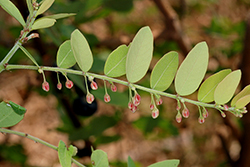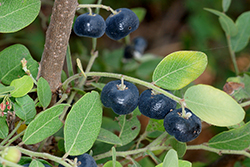e-Flora of Thailand
Volume 8 > Part 2 > Year 2007 > Page 499 > Euphorbiaceae > Phyllanthus
28. Phyllanthus reticulatus Poir.wfo-0000271947
in Lam., Encycl. Méth. 5: 298. 1804; Müll.Arg., Linnaea 32: 12. 1863; in DC., Prodr. 15, 2: 344. 1866; Hook.f., Fl. Brit. Ind. 5: 288. 1887; J.J. Sm., Meded. Dep. Landb. 10: 63. 1911; Craib, Bull. Misc. Inform. Kew 1911: 459. 1911; Merr., Enum. Philipp. Fl. Pl. 2: 394. 1923; Ridl., Fl. Malay. Penin. 3: 202. 1924; Beille in Lecomte, Fl. Indo-Chine 5: 575. 1927; G.L.Webster, J. Arnold Arbor. 38: 57, 1957; Backer & Bakh.f., Fl. Java I: 467. 1963; Airy Shaw, Kew Bull. 26: 322. 1972; G.L.Webster in Dassan. & Clayton, Revis. Handb. Fl. Ceylon 11: 217. 1997.— Kirganelia reticulata (Poir.) Baill., Étud. Gén. Euphorb.: 613. 1858.— Cicca reticulata (Poir.) Kurz, Forest Fl. Burma 2: 354. 1877. Fig. 55: C; Fig. 63.
Accepted Name : This is currently accepted.
Description : Shrub or small tree, up to 4 m high, branchlets terete, densely hairy. Stipules lanceolate or linear oblong, 1–3 mm long, densely hairy outside, glabrous inside, apex acuminate, scarious. Leaves: petiole 1.5–3 mm long, hairy; blade elliptic, (1–)1.7–3.5(–4.6) by (0.6–)1–2.5 cm, chartaceous, hairy on both sides, base cuneate, margin entire, apex obtuse or orbicular, nerves in 5–9 pairs, reticulation conspicuous on both sides. Flowers in bisexual cymes, each with several staminate flowers and (1)2 pistillate flowers. Staminate flowers: pedicel 2.7–6.5 mm long, hairy; sepals 5 or 6, oblong, obovate or suborbicular, 1.7–3 by 0.75–2 mm, outer ones sparsely hairy outside; disc glands 5 or 6, semi-orbicular or triangular; stamens 5, imbricate, 3 stamens joined together into a staminal column of ca 0.5 mm long, the other free, filaments ca 0.3 mm long, anthers 0.3–0.6 mm long. Pistillate flowers: pedicel 4–8 mm long, sparsely hairy; sepals 5 or 6, oblong, elliptic, suborbicular, 0.8–2 by 0.6–1.4 mm, outer ones hairy outside; disc glands 5 or 6, semiorbicular; ovary glabrous, 8–10-locular; styles 0.1–0.4 mm long; stigmas ca 0.1 mm long. Fruits: pedicel ca 3 mm long; fruit baccate, 49 mm in diam., depressed globose, blackish or purplish. Seeds plano-convex, 2.2–2.5 by 1.5 mm.
Thailand : NORTHERN: Mae Hong Son, Chiang Mai (Angka Noi, Doi Chiang Dao, Doi Inthanon, Doi Saket, Fang), Lampang (Doi Luang, Ngao, Chae Hom), Phrae (Huai Hom), Tak; NORTH-EASTERN: Phetchabun (Lom Sak), Loei (Phu Kradueng); EASTERN: Chaiyaphum (Nong Bua Daeng), Nakhon Ratchasima (Bua Yai, Pak Thong Chai), Surin (Thatum); SOUTH WESTERN: Kanchanaburi (Si Sawat), Prachuap Khiri Khan (Kan Kradai); CENTRAL: Chai Nat, Suphan Buri, Ang Thong, Saraburi (Sam Lan), Nakhon Pathom, Nakhon Nayok (Nang Rong, Salika), Krung Thep Maha Nakhon (Bangkok); SOUTH-EASTERN: Sa Kaeo, Chon Buri (Khao Khiao, Si Racha), Rayong (Khao Cha Mao), Chanthaburi (Pong Nam Ron); PENINSULAR: Phangnga (Ko Surin Nuea, Ko Yao Yai), Phuket, Krabi (Lanta), Trang (Khao Chong), Songkhla (Tepha), Pattani (Khao Kala Khiri).
Distribution : India (type?), Sri Lanka, Burma, China (Hainan, Hong Kong), Vietnam, Laos, Peninsular Malaysia.
Ecology : On open space, waste ground, dipterocarp or evergreen forests, 500–1,150 m alt.
Vernacular : Kang pla khruea (ก้างปลาเครือ); kang pla khao (ก้างปลาขาว)(Chiang Mai, Ang Thong); mat kham (หมัดคำ)(Phrae); ta-kha-kho-khuey (ต่าคะโคคึย), sa-brae-thi (สะแบรที)(Karen-Mae Hong Son); am ai (อำอ้าย)(Nakhon Ratchasima); kraong (กระออง)(Prachuap Khiri Khan); kha khlong (ข่าคล่อง)(Suphan Buri); ma yiao (หมาเยี่ยว)(Nakhon Pathom); kang pla daeng (ก้างปลาแดง)(Surat Thani).




